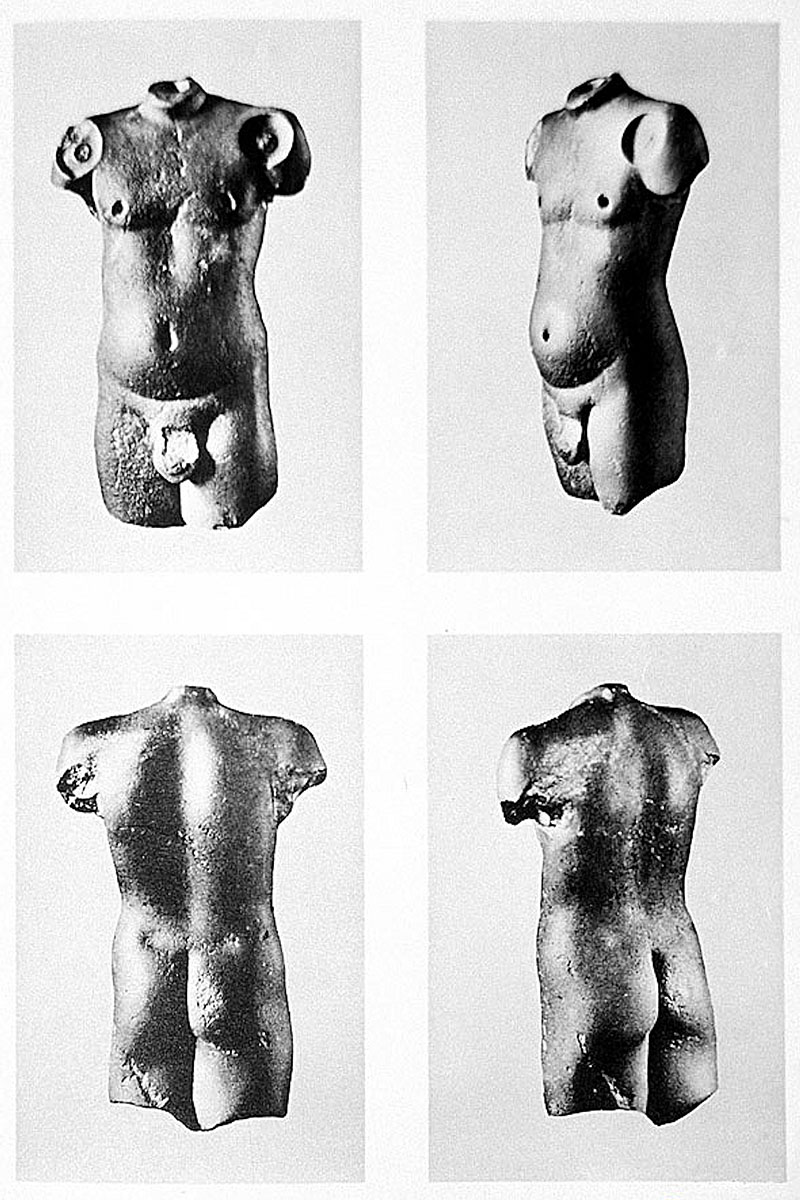Carved in red jasper stone, this statuette of a nude male torso with a missing head, arms and legs was excavated in Harappa in Punjab in present-day Pakistan in 1928-29 by Indian archeologist Madho Sarup Vats, who ascribed it to Stratum III of the Indus Valley Civilisation. The statuette is 9.2 centimetres tall, 5.5 centimetres wide and 3 centimetres deep. Most notably, it features naturalistic contours, denoting a deliberate stylistic choice in the shaping of a rounded midriff towards the bottom of the torso that was achieved using a sculptural technique rather than the use of lines or striations.
The statuette is rendered in anatomical detail. The head and arms are missing and the legs appear broken off. The genitalia of the figure have been defaced, although they appear to have originally been carefully modelled and sculpted. The shoulder joints have recesses for the attachment of arms, though there are no such provisions for the legs. There are two front-facing, disk-like indentations on both shoulders of the figure, which may have been used to attach garments to the statuette or for inlaying jewellery; the perforations in the nipples may have been used for similar inlay work. The front of the statuette is modelled as static, while the back is asymmetrical, suggesting a leaning pose or the shifting of body weight on one leg, resulting in the observation that the statuette may have been modelled after a moving or dancing figure.
The visual characteristics of the statuette have led to a great deal of speculation regarding its origin. Vats believed that the statuette dated to the Mature Harappan Phase of the Indus Valley Civilisation. This is primarily due to the usage of tube drills to create recesses in the shoulder joints and allow dowels to attach the head and limbs separately — a practice unique to the terracotta figurines of the Indus Valley.
Vats’s claim was disputed by archaeologist John Marshall, who was of the opinion that the statuette could only be ascribed to a later historical period, such as the Gupta Dynasty. Marshall arrived at this conclusion by comparing the statuette with other finds dated to the Indus Valley, which he considered inferior in terms of anatomical detail, technique and expertise. However, Marshall revised his opinion upon further study of these finds, conceding that the sculptors of the Indus Valley were experienced enough to have had little trouble carving the male torso. The Red Jasper Male Torso has also been compared to the Lohanipur torso statuette, dated between the Mauryan Period and Kushan Period, owing to similarities in posture. However, the polished surface treatment of the Lohanipur torso, its method of depicting body posture and symmetry and the absence of sockets and recesses for attaching limbs have rendered this comparison inaccurate.
The frontal nudity of the statuette has also generated much speculation owing to the fact that the depiction of complete nudity is not characteristic of Indus Valley art. While the nudity, and the presence of genitalia, are not necessarily symbolic of sexuality or fertility, the absence of such a depiction might represent a negation of sexuality in the figure. However, without a full understanding of the purpose of the statuette, these interpretations remain conjecture.
At the time of writing, the Red Jasper Male Torso is a part of the Pre-History and Archaeology collection at the National Museum, Delhi.






![The façade of the Maneckji Seth Agiary, a Zoroastrian fire temple, is a standout example of the popularity of the Persian Revival Style in Western India in the 19th and 20th centuries. This style was often seen in the architectural patronage of the Parsis, who emerged as one of the most influential mercantile communities of British India. Popular motifs of this style, like the mythical lamasus (winged bulls with human heads) and the faravahar (a winged guardian spirit in Zoroastrianism), drew on the historical art and architecture of the Achaemenid and Sasanian empires from sites like Persepolis, Bisotun, Taq-e Bostan, Naqsh-e Rostam and Naqsh-e Rajab in Persia.
The Parsi community’s adoption of this style occurred largely due to their networks of global commerce and politics, allowing them to access and translate research of ancient Persia into visible symbols that underlined their association with antiquity, imperial power, and art.
نمای آتشکدهی زرتشتی مانِکجی سِت نمونهی بارزی از رواج سبک «احیای [معماری] ایرانی» در غرب هند طی سدههای نوزدهم و بیستم است. این سبک غالباً در بناهایی دیده میشد که پارسیان، از بانفوذترین جوامع بازرگان در هند بریتانیا، بانیشان بودند. نقشمایههای محبوب این سبک، مانند گاو بالدار اساطیری (لاماسو) و فَروَهَر (روح بالدار نگهبان در دین زرتشت)، برگرفته از هنر و معماری شاهنشاهی هخامنشی و ساسانی، در جاهایی چون تخت جمشید و بیستون و طاق بستان و نقش رستم و نقش رجب، بود.
اقتباس جامعهی پارسیان از این سبک بسیار مرهون روابط گستردهی تجاری و سیاسی آنها بود که دسترس به پژوهشها دربارهی ایران باستان و برگردانیدن آنها به نمادهای بصری را ممکن میکرد و بر پیوند پارسیان با دوران باستان و قدرت شاهنشاهی و هنر تأکید میکرد.](https://mapacademy.io/wp-content/plugins/instagram-feed/img/placeholder.png)
